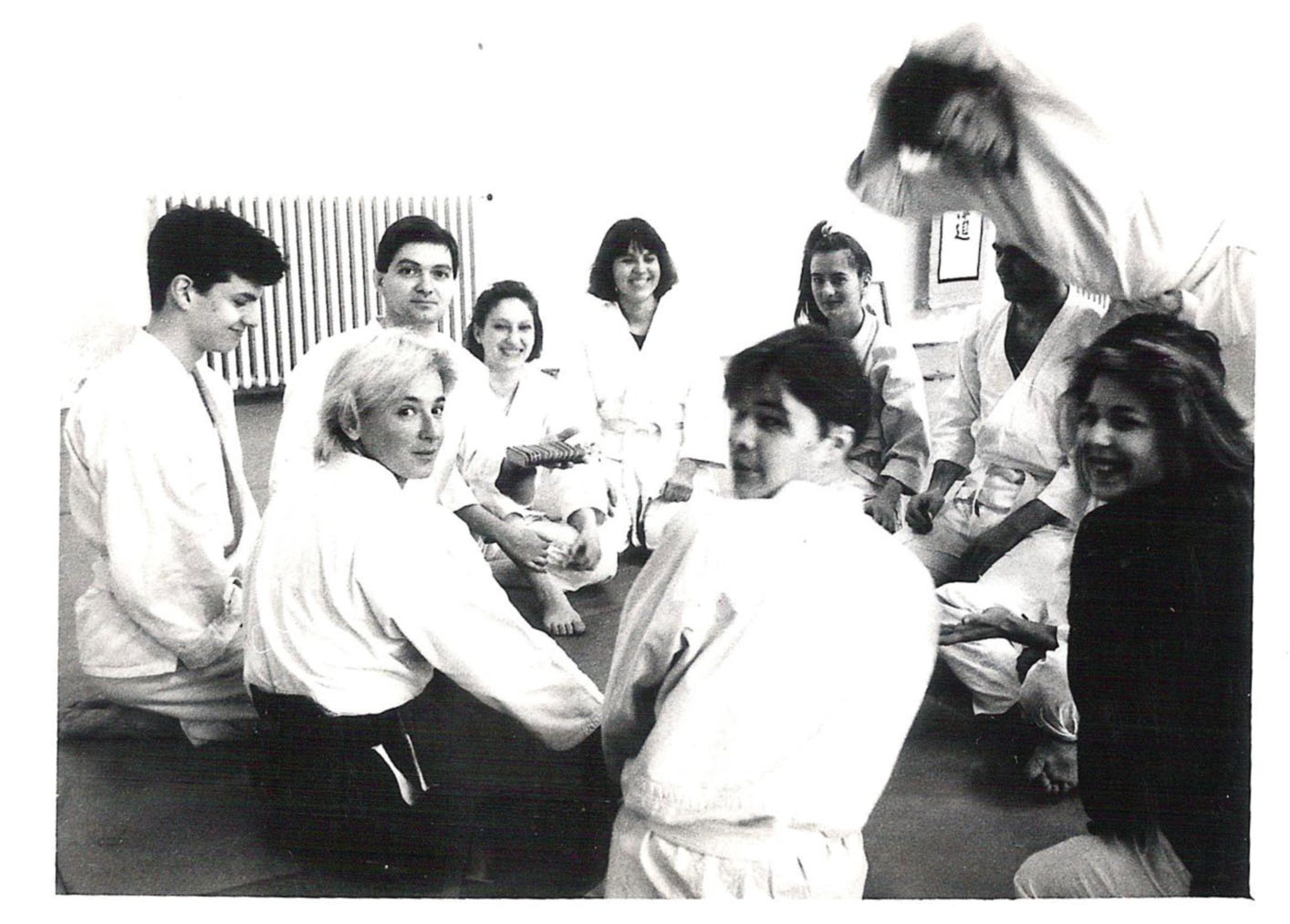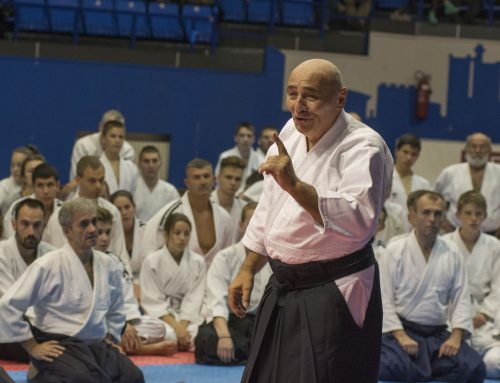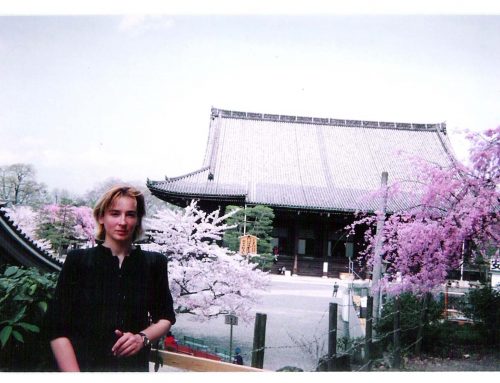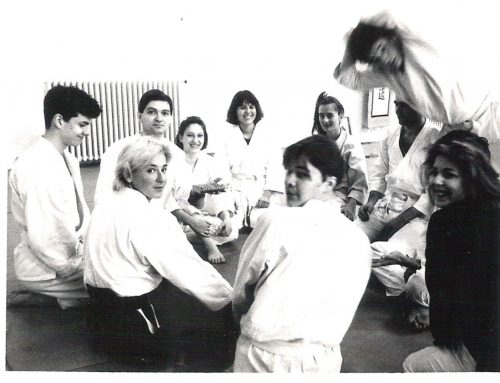Name of Jelena Vrzić Sensei, 6th DAN Aikikai is well known in Aikido world and doesn’t need special introduction. Beside she is the first female aikido master in Serbia (Yugoslavia at the time she obtained 1st DAN black belt) she is also a great adventurer and one of the most dedicated aikidokas in Serbia.
The idea for this interview was born as a part of preparation for 50th anniversary celebration of aikido in Serbia. Since this year is the year of anniversary in Serbia, there is a desire to present aikido life in the SFRY in the end of 1970’s and beginning of 1980’s to young practitioners of today.
Sincere thanks to Jelena Vrzić for all help and for allowing me to reproduce pictures from her personal archive. All images remain the property of the owner.
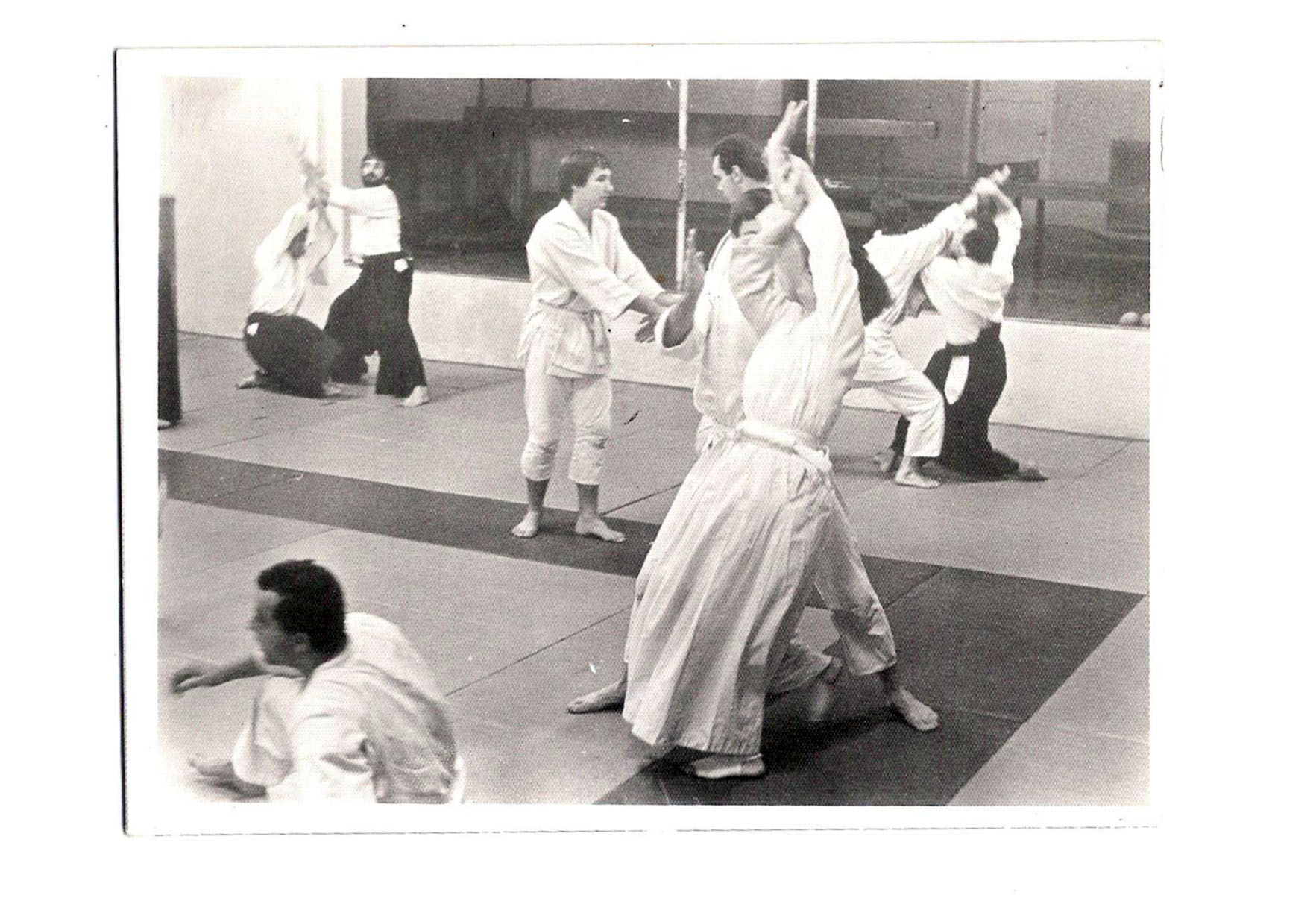
Training in DTV Partizan, in the 80s
Seishin Aikido: How did you find out about aikido in 1979 and how did you decide on training aikido?
JelenaVrzić: I wanted to do a martial art since I had to find a way to channel my naturally developed strength. So I trained judo for two years with Svetomir Ivanović – Es at the Partizan stadium. By accident, it was in the same dojo where aikido in Yugoslavia started, just at different working hours.
Judokas training in the dojo founded aikido section in 1968, and that is where practicing aikido in Serbia (SFR Yugoslavia) began. It was the same place where my sensei, Jovica Stanojević, was practicing. But destiny decided it was not the time for me to discover what was going on at different training hours saved for jujutsu, as they said that was the name of the art.
I practiced judo when I was 14 and 15 years old and I started doing aikido when I was 17. So, I was late for the start for those few years.

In front of the DTV Partizana Standing: Gordana Aleksić, Joca Jocković, Mirko Mrđa, Sale Kneeling: Dušan Kanački, Jelena Vrzić, Predrag Kovačević, Jovica Stanojevič
SA: What made you go and see that what they called jujutsu?
JV: Judo wasn’t what I wanted, even though my judo sensei had high hopes for me. But, just simple as that, for some unknown reason I wanted something different. So I started going swimming when I was 15 and I was training for swimming marathon. Swimming is my great love. It was only recreational because I was too old to join a club.
Once, in 1978, a friend of mine and I came across a poster downtown in Bulevar revolucije street. There was a man throwing another on the poster. The falling guy was doing a very big fall, which I found quite interesting. It was written: aikido. We remembered the address, but we had no idea where it was.
SA: You couldn’t take out your phone to take a picture of it, as you can do it today?
JV: Yeah, yeah, yeah (laugh). We had to remember the address: No. 3, Boška Petrovića street. I remember it even today as if it were a magic word. However, we didn’t start training for another year. When we, finally, looked for it on the map, we realized it was quite close to my home – only a half an hour walk.
We went to see where the dojo was on a school break in August 1979 and when we came, we found the dojo being renovated so we couldn’t start before November when we, finally, come to the dojo. There, we met a bearded man with curly hair who told us he trained aikido and that the sensei was about to come in short time. It was a Jovica Joca Jocković, the first aikido person we met. And then, the sensei came – Jovica Stanojević, a 27 year-old bearded young man with a wonderful smile. We told him we wanted to start training, so he invited us in.
The dojo was closed by the ground from three sides and by windows on the fourth, where was also the entrance. The dojo was a part of the Partizan, physical education society which emanated from the Soko societies. The Soko societies were places to cultivate physical education before the WW2, and after the WW2 they were transformed in Partizan societies.
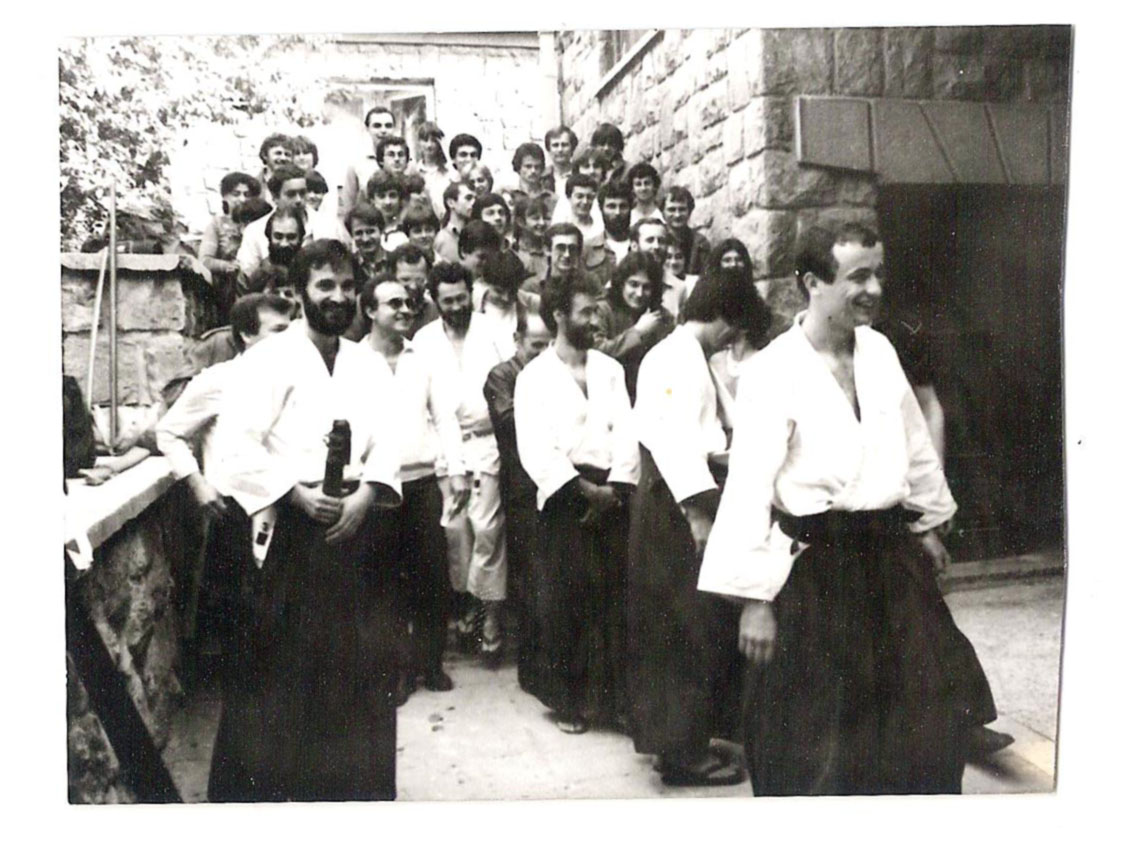
Waiting for enter the dojo for Fujimoto senseis seminar. First row Jovica Stanojević, Dragiša Jocić, Fujimoto sensei, Velibor Vesović
SA: It is interesting to say that it was a time of self-management, and that the Society did not function the same way dojos function today
JV: At the time, everything was a part of socialistic system. We paid the fee, a small one, quite symbolic. The person giving the training wasn’t paid because he/she was an amateur, but the Society annually provided all the equipment for them and also paid vocational perfection, that is, they paid the trips to seminars as well as seminar fees. It was the way to support the advanced, those who were giving the lessons, in perfecting what they were doing.
We had 99 tatamies in the dojo. They were approximately 0.75m x 1.5m in size. In the early 1990’s, the capitalistic system was slowly starting to predominate, so the dojo was taken by the local groups. In the meantime, during 13 or 14 years, the time I was practicing in the dojo, we renovated the tatami 4 or 5 times, we did the painting and tile remodeling…
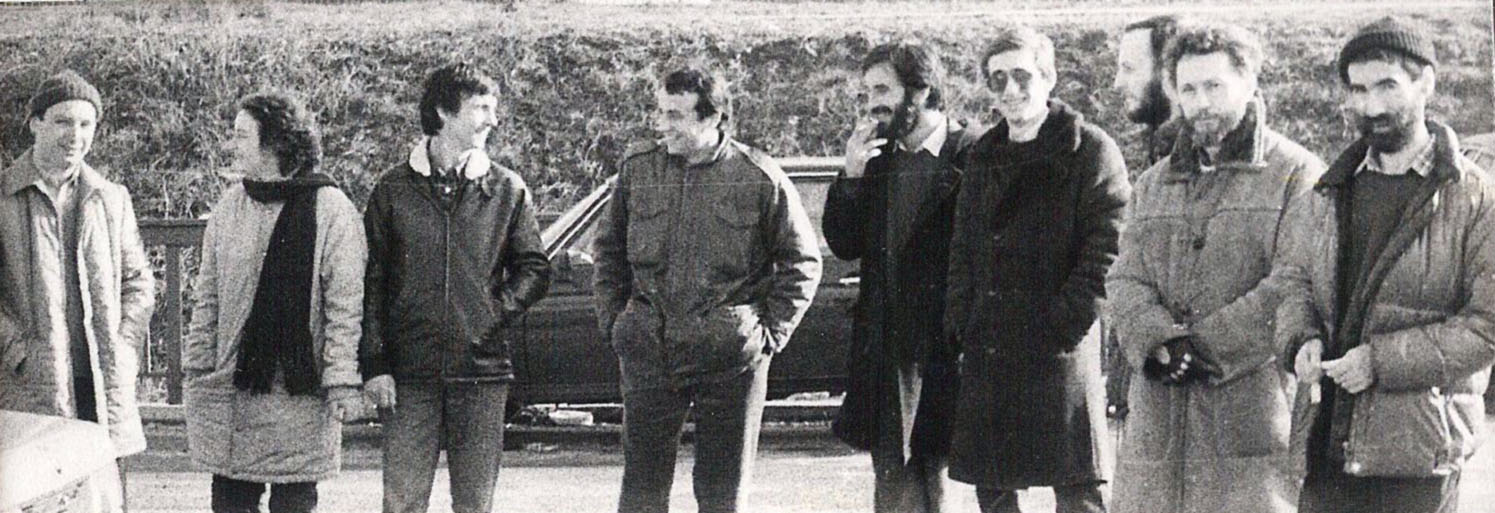
Njegoš Đaković, Jelena Vrzić, Drago Bogdnović, Velibor Vesović, Jovica Stanojević, Mirko Mrđa, Boško, Predrag Bata Milošević (founder of SVEBOR), Dragiša Jocić
SA: You did everything by yourselves…
JV: That was our home. I had the dojo key. We used the dojo to celebrate New year’s eves and had birthday parties. We had all pieces of gymnastic equipment – balanced beam, double-leveled gymnastic apparatus, wall bars, bucks, climbing rope, rings,… We also had volleyball net, table tennis tables and basketball hoops. It was a house of sport, which is a beautiful thing, and it was truly given, free of charge, to people who wanted indeed to use the facility.
SA: So, there was great enthusiasm…
JV: Yes, even more since it was something completely new. There were only four clubs at the time I started training, so there were approximately one hundred people devotedly doing aikido. What was the way of learning? A Japanese teacher gave a seminar or you went abroad for the seminar. My sensei often attended seminars with Tada sensei. Then when you get there, you keep your eyes wide open, and try to remember as much as you can. After you come back, everyone devotedly practices the thing you remembered.

Mirko Jovandić and Jovica Stanojević with first genration of students on Hosokawa sensei seminar. 1984-godine Standing: Mirko Jovandić, Njegoš Đaković, Jovica Dimitrijević, Drago Bogdanović, Predrag Bata Milošević, Mirko Mrđa Seiza: Velibor Vesović, Jovica Stanojević, Hideki Hosokava, Dragiša Jocić, Gradimir Nikolić, Branko Lušičić
SA: You didn’t have any camcorders at the time…
JV: No, there was only Super8 camera, so those who had it were able to do some shooting, but generally, there weren’t any videos. It was all recorded in heads and hearts, arms and legs. Whoever went abroad for a seminar, no matter their aikido knowledge, the person was obligated to give a few trainings to communicate to others what they had learned. We selflessly shared everything with one another and there was truly great enthusiasm.
We had five trainings a week, but we had boken and jo trainings every day. We would compete with each other who would do more suburies, and we did thousands. There is a wide plain at the Partizan stadium now, but once it used to be а thick forest. We set an old tyre there to beat it with boken. We used every spare moment for additional learning.
SA: I understand, plenty of those people still do aikido?
JV: Milutin Karaičić, Zoran Obradović (5th DAN Aikikai) and I made the generation that took examinations together. Zoran Obradović started two years before me, but somehow we synchronized, and took examinations together from 3rd kyu to 2nd DAN. I also took mutual examinations with Milutin since from my 4th kyu until 1st DAN. He had practiced with Mirko Jovandić before he started training with us.
SA: Who was in the previous generation of Jovica’s students?
JV: The first generation of Jovica Stanojević’s students were Drago Bogdanović (6th DAN Aikikai), who is now in Italy, Velibor Vesović (7th DAN Aikikai), who is in Serbia, Njegoš Đaković (6th DAN Aikikai), who is also in Belgrade, Mirko Mrđa (5th DAN Aikikai) and Dragiša Jocić (7th DAN Aikikai), who is in Switzerland. So, two people have obtained 7th DAN Aikikai so far, Jocić and Vesović.
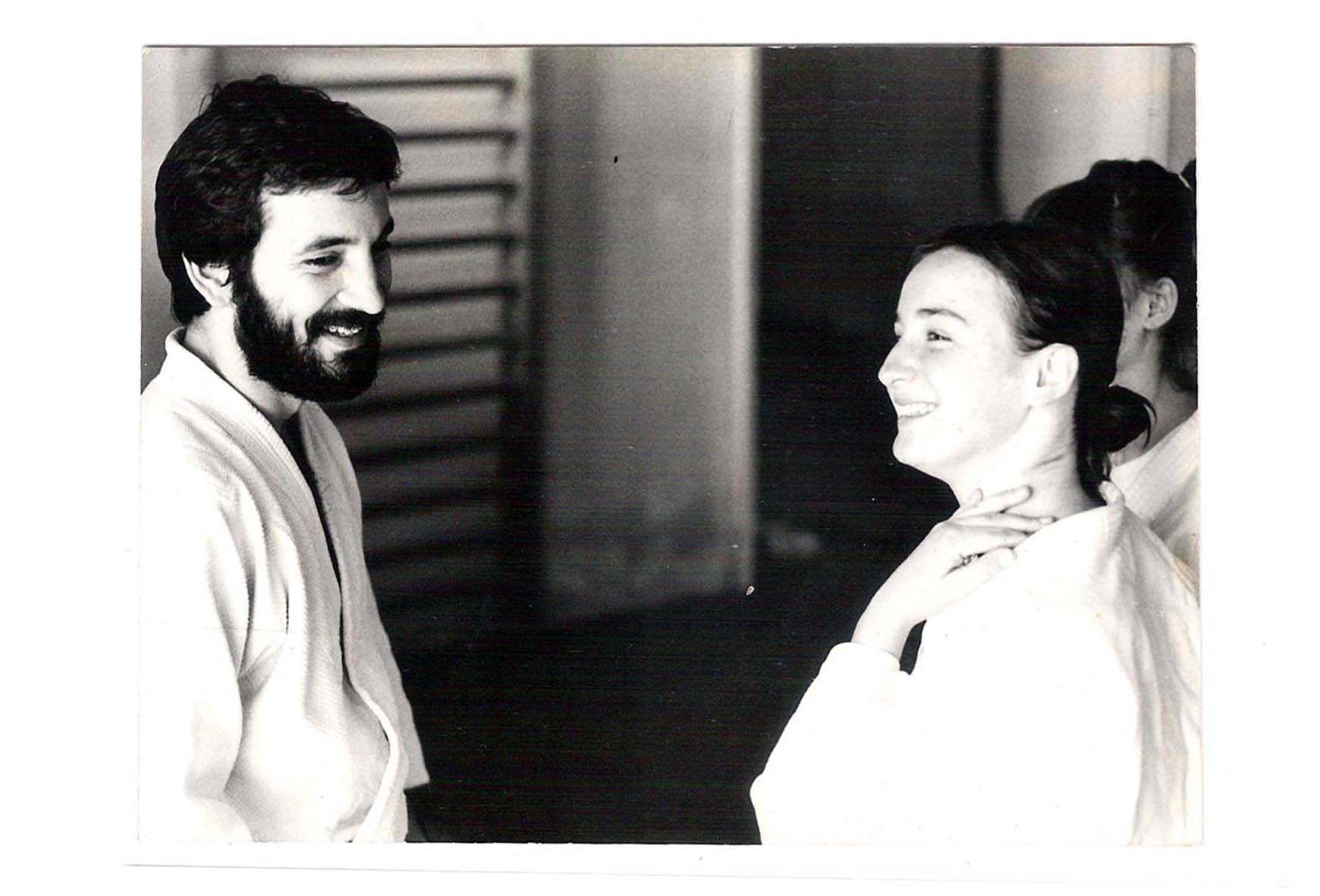 SA: Trainings were given by Jovica Stanojević, and last time you told me ‘I fell in love with aikido for the first time when I saw Jovica doing…‘
SA: Trainings were given by Jovica Stanojević, and last time you told me ‘I fell in love with aikido for the first time when I saw Jovica doing…‘
JV: Doing iriminage. Really big iriminage. Jovica was doing gymnastics before he started aikido. He started doing aikido when he was 19. Before that, he was the Serbian national champion in gymnastics. Jovica is my greatest aikido impression, and I’ve seen plenty of things. Next year will be my 40th anniversary of doing aikido continuously every single day and I’ve attended many seminars, I’ve met many masters but the person, the aikidoka that has left the greatest impression is Jovica Stanojević. We would listen to his every word of the speech with the utmost attention at the end of a training. Each of his words were those we remembered and thought about until the next training. He was unbelievably mature for his age. He passed away before he turned 33 and that was one of the greatest loss I had experienced in my life.
Compared to people of his age, it seemed as if he was twenty or thirty years older. He was eloquent, he shone with spirituality, he was handsome and he was able of supreme body motoricity. He was an extraordinary person indeed.
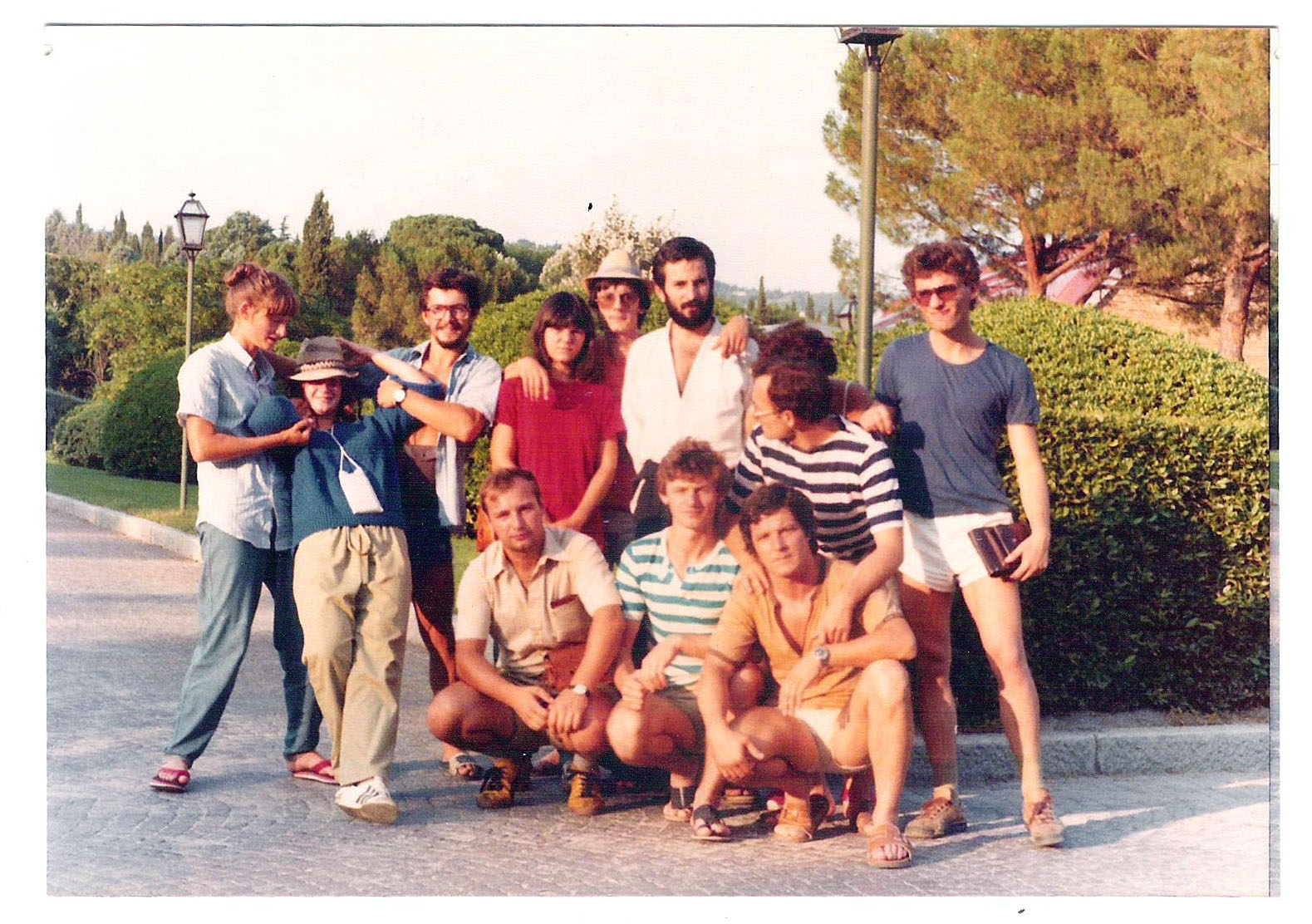
In Firenza, 1980 After Jovice Stanojević Dan exam Standing: Gordana Aleksić, Vrzić Jelena, Predrag Kovačević, Lidija, Drago Bogdanović, Jovica Stanojević, Gradimir Nikolić, Goran Luković Kneeling: Njegoš Đaković, Milutin Karajčič, Mirko Jovandić
SA: You travel abroad for a seminar in 1980 for the first time, after only a year of training , and, the thing that’s interesting is that you go straight after a working camp
JV: 1980 is a very special year. That’s the year Tito died, and we spent very tense summer, since the whole world expected Yugoslavia to collapse right after his death. The working camp’s task was to prove everyone wrong, to prove that our country, brotherhood and unity would prevail no matter what and that socialistic system would survive apart from the Tito’s image.
We used to get up at 3.30am every morning in the camp. We would be doing some workouts while stars were still shining in the sky. We went to the working site after we had breakfast. I was in Zagreb and we were building a part of a motorway along berms on the Sava river. Being ecstatic and in love with aikido, a friend of mine and I came to the camp during a break in training; we wouldn’t come otherwise, since we never missed trainings – not for a million dollars. When we came to the accomodating barrack, the two of us took up the task to clean 70 mattrasses. We did it with bokens which we brought with us to practice in our free time. So, in the beginning of the working camp, we beat mattrasses with bokens. Later, we exchanged bokens for spikes and other tools.
Right afterwards, we set off to Italy. Jovica took third DAN examination that year. Third DAN was such a rarety in Europe at the time. Fujimoto sensei had fourth DAN. You could count on fingers of a single hand the people possessing third DAN in Europe then. Our group attending the seminar numbered over 10 people. It was the most numerous group after the Italian’s.
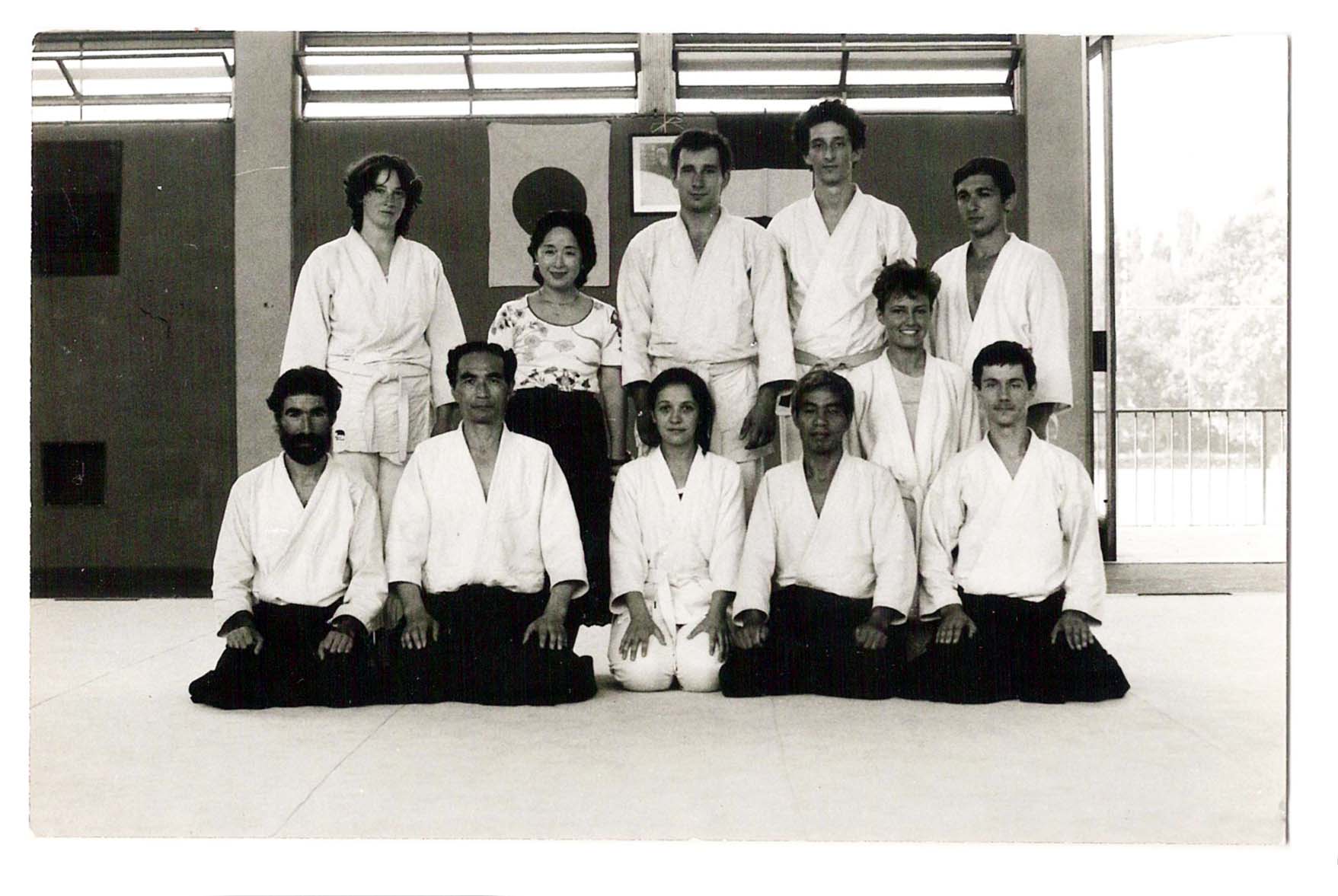
In Firenca 1984 Standing: Jelena Vrzić, gđa Tada, Zoran Obradović, Marko Živković, Simo Simić Kneeling: Renata Jocić Seiza: Dragiša Jocić, Tada sensei, Zorana Dimitrijević, Hosokava sensei, Drago Bogdanović
SA: At the time, aikido was being practiced in Italy, Germany, France and Yugoslavia?
JV: Yes. We started among the first. People who were practicing judo saw Tada sensei’s seminar and they were thrilled about the thing, so they started practising based on what they saw and remembered. Then Mirko Jovandić and Jovica started attending Tada sensei’s summer camps and collecting as much knowledge as they could.
SA: So, the first seminar in Belgrade took place as early as 1973?
JV: Yes, Tada sensei’s assistant, Nemoto sensei, gave the seminar. I met him at the Italy Aikikai’s 50th anniversary celebration a few years ago. He stopped doing aikido professionaly right after he left Italy and now he does aikido as an amateur. But, a much important event was Tada sensei’s seminar in 1974 in the Firefighter Headquarters. That was a great thing for aikido in Yugoslavia, since it was actually based on Tada sensei’s teachings, no matter other influences came later.
SA: Being, geographicaly, closest to Italy, a country with one of the oldest aikido traditions in Europe, it was quite natural to consider it the closest sourse of knowledge
JV: There were very few Japanese teachers in Europe at the time. Tamura sensei was in France, Tada sensei in Italy and Chiba sensei in England, but that’s all
SA: Asai sensei in Germany?
JV: No, Asai sensei was Tada sensei’s assistant. There’s an impressive photography, in Rome, in Dojo Centrale, of Tada sensei throwing Asai sensei, who is, clothed in white hakama, literaly, flying 5 meters away. Later, Asai sensei was sent to Germany.
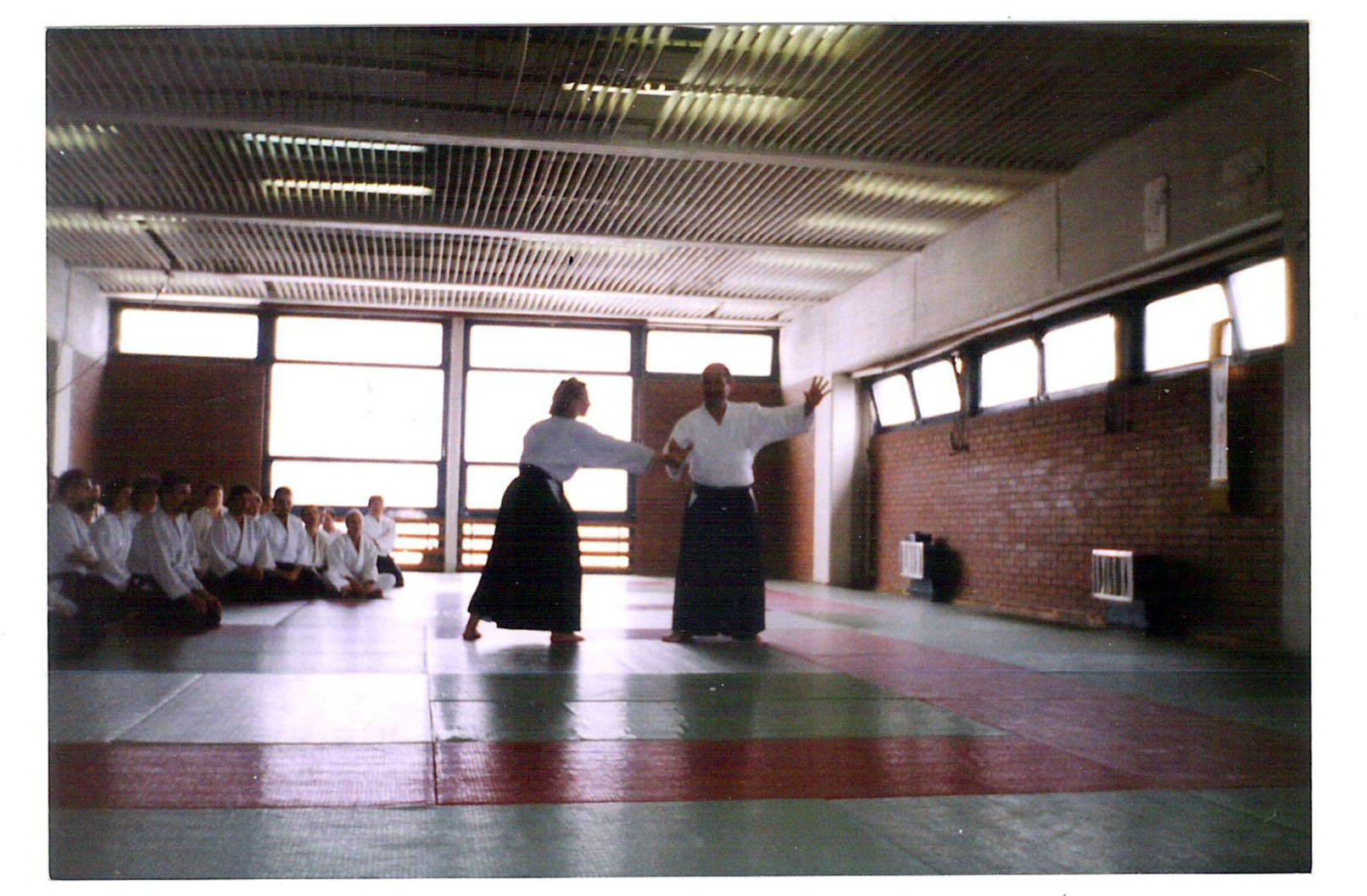
Belgrade 1997, Ikeda sensei, Uke Jelena Vrzić
SA: There is a great number of masters brought to Italy by Tada sensei….
JV: That’s true. Ikeda sensei was the first of his students to arrive. He was accomodated somewhere in Naples. Hosokawa sensei, who is also Tada sensei’s student, followed. Fujimoto sensei wasn’t Tada sensei’s student and was sent to Italy by Hombu dojo.
SA: The first seminar you attened was with Fujimoto sensei?
JV: The first seminar I attended as a spectator took place a week after I started training in November 1979. Fujimoto sensei was the first Japanese teacher I have seen. His seminars usually took place in April and November in Belgrade every year. So, the first seminar I attended was the above-mentioned one with Tada sensei in 1980 in Coverchiano (Casa Italia, central training ground and technical headquarters), in Florence.
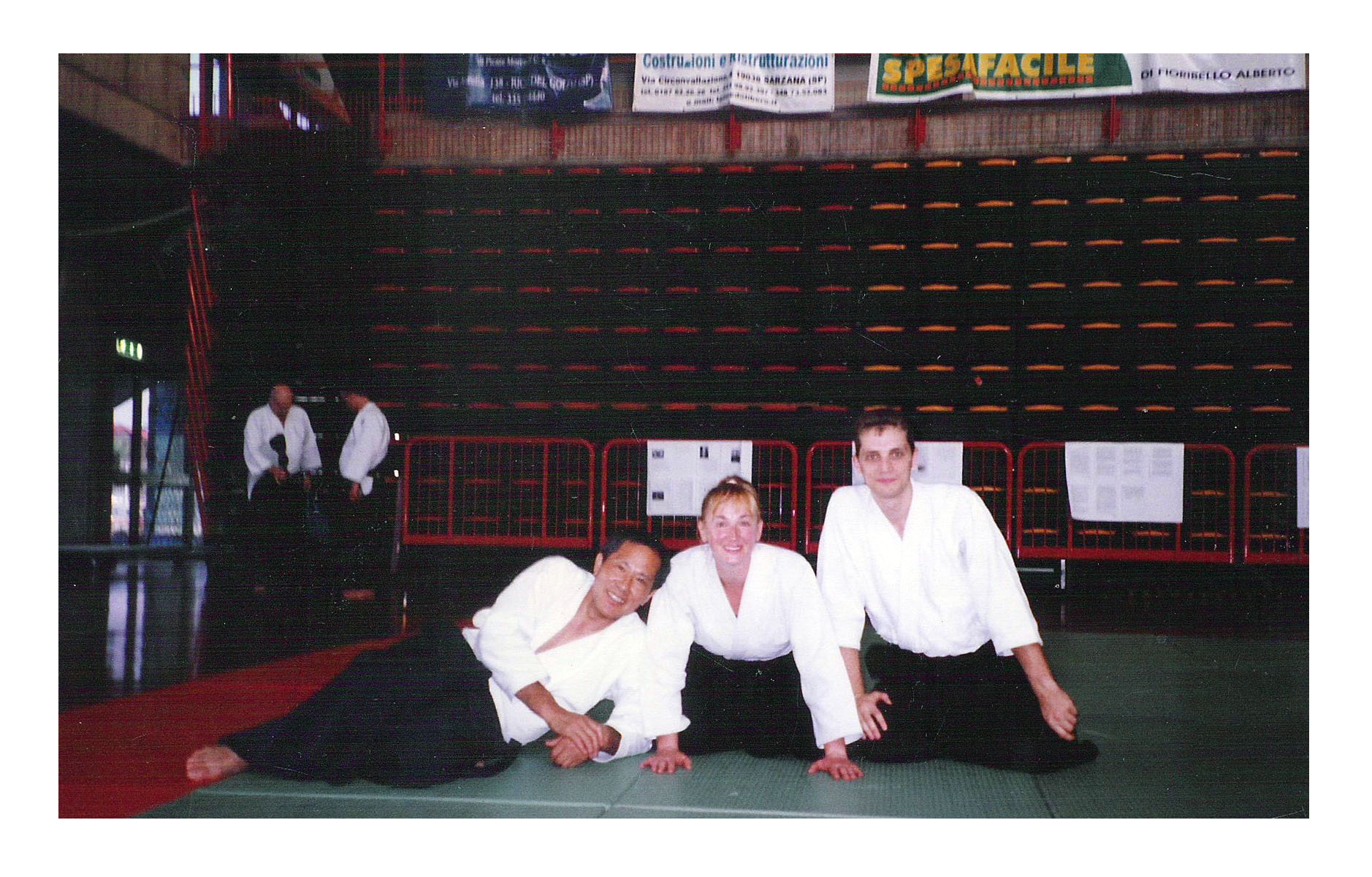
La Spezia, 2006 2006 godina, Fujimoto sensei, Jelena Vrzić, Milan Ilić
SA: How often did you travel at the time? Which were the greatest impression and loveliest memories of the first seminars?
JV: I had attended Firenza seminars constantly every year until 1995. I attended KiNoRenma seminar in Dojo Centrale in Rome in 1981 for the first time. KiNoRenma is the spiritual part of aikido, which was separated from the rest by Tada sensei for practical reasons. Our every training begins with breathing techniques and streching techniques, which are both parts of Japanese yoga or KiNoRenma. That’s where the sense reception enhancement, the spacial sense development and the state of a still mind achievement all belong – to the part that we cannot see, but is the most important. I had to stop attending summer camps in Coverchiano in 1995, since, afterwards, we needed visa to enter Italy.
Coverchiano International summer camp and KiNoRenma seminar took place right one after the other and lasted for three weeks. In the winter, there was a tradition to spend 10 to 15 days visiting Fujimoto sensei’s dojo in Milano. I slept and trained in the dojo. Fujimoto sensei was a true gentleman. He was an attentive and accomodating man, a great teacher and a true friend.

Tada Sensei Uke Drago Bogdanović
SA: Could you describe Tada sensei, in short? The same way you described Fujimoto sensei?
JV: Tada sensei is someone very special in my life. At first, he was my teacher’s teacher – now he is my teacher. He is someone I find to be a genuine gentleman and someone I honestly appreciate for calling our attention to KiNoRenma, which enables us to see the unseenable in aikido, that is, to understand aikido and its philosophy better. As far as I know, noone in Japan teaches the same way.
SA: Can you, in short, compare Fujimoto sensei with Tada sensei from aikido point of view?
JV: Fujimoto sensei’s large movement and aikido style resembled Tada sensei’s more than his direct students, since Fujimoto sensei remined of Tada sensei in shape. Being physically different from Tada sensei, both of his students, Ikeda sensei and Hosokawa sensei, had to develop their own personal aikido styles, which are pleasant and interesting in their own way. All of these teachers have great impact on my work.
SA: That’s something what Japanese define as the principle of ShuHaRi?
JV: An aikidoka creates their own style in accordance with their own characteristics, physical abilities and experience. Everyone needs to find their own clothes. We cannot wear our teacher’s clothes or we would look ridiculous. At first, we copy the master, but the minute we grow up, we need to find our own expression. Our aikido style changes along with our personal change. Hence, nothing’s definite. It is necessary to keep developing our personalities in the way it is also reflected in our skill. If we didn’t change, it would mean we’re in the state or stagnation, or retardation, because – you either go forwards or backwards.
SA: May I ask about the 1980’s again? At the time, travelling experience was absolutely different than today – no bookings, no internet, you can’t see any pictures of accomodations or activities available. You just buy the ticket and take your passport, which was the only needed document for travelling abroad until the 1990’s.
JV: Yes, it was quite magnificent. At first, we were accompanied by the grown-ups, but in 1981 I went only with my best friend. Two 18-year-olds dared to ride a train alone. We attended the Florence seminar with Tada sensei, in Coverchiano. Afterwards, I went to Rome for a KiNoRenma seminar, which lasted only 4 days.
We were allowed to sleep in the dojo in Rome, but we slept in a camp in Florence. At first, we slept in a near-by camp, but later we moved to a camp in the hills above Florence, 7 or 8 kilometres from the dojo. The view from up there is absolutely breathtaking. I loved to get up at 5am and walk to the dojo, to enjoy the nature while having breakfast on the way, since the area looks divine, full of patrician villas and smell of olive groves and vineyards. The walk to the dojo was a part of every day ritual.
The morning training lasted 3 hours. It’s sometimes as hot as 50C in Florence. In 1983 it was 54C in the dojo, and we all wore gies, practising boken. The dojo is, actually, the National football team of Italy official sports centre, so we could or couldn’t always use the sports centre swimming pools, in accordance with the presence or absence of the football players.
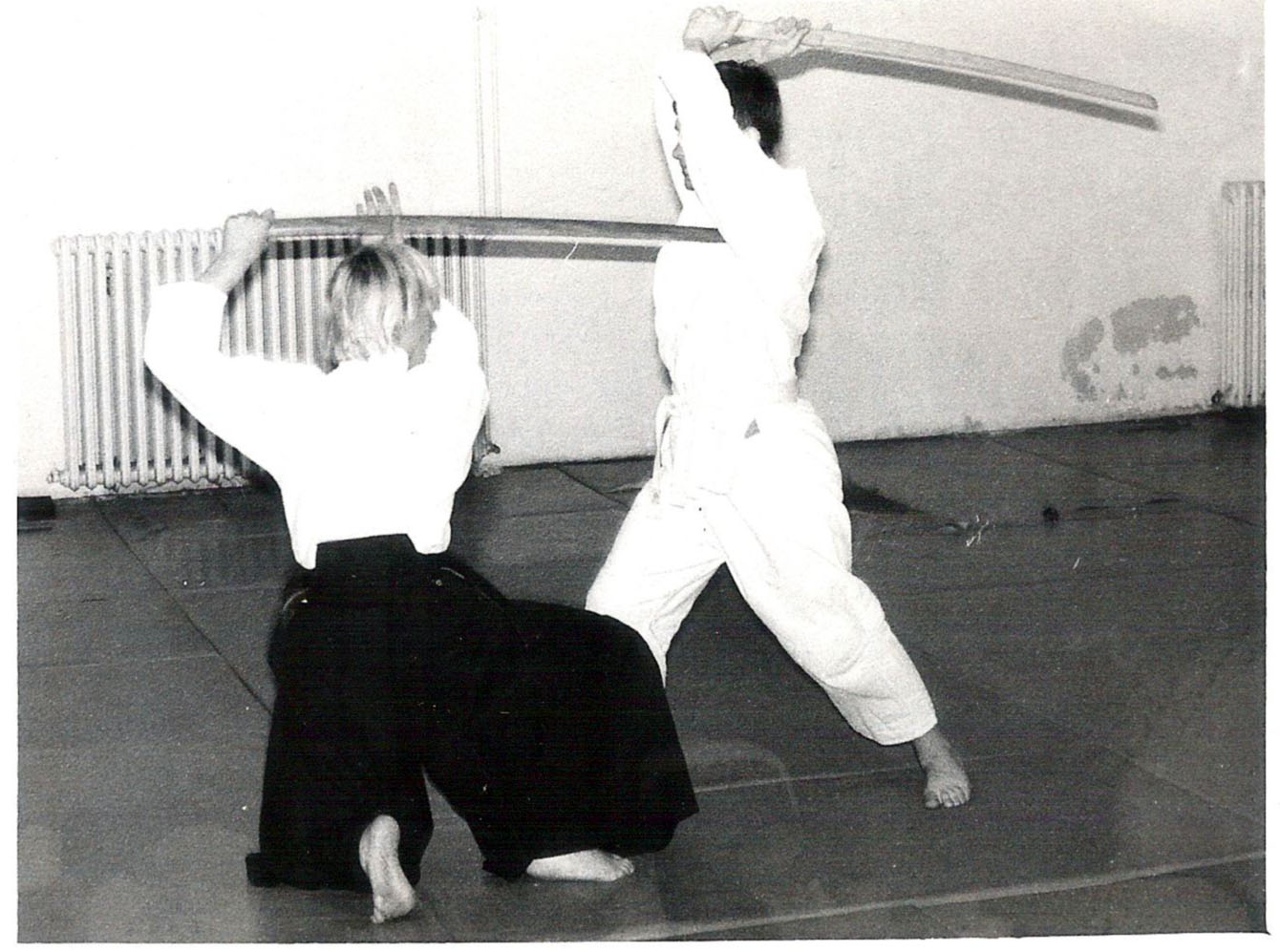
Jelena Vrzić Uke Minić Milan
: I heard there were long and exhausting trainings at the time
JV: That was the time of exaggerating in everything. We all wanted to be samurais. Samurais were superhumans in our vissions, so we wanted to show we were capable of the same power by practicing. We used to do frog jumps for 50m (which is the Florence dojo length) 50 times. Those were the times of broken menuscuses. We all did the jumps to our limits’ end only to see what we were able to withstand. Tada sensei would often take the afternoon training outside, so we would practise with boken and jo for 2 or 3 hours in the sun.
The jo kata that was created by Tada sensei was making in the process in 1981 and it gradually was developed to its final form, the one we do today. It’s been done in Embukaies since 1982 and 1983. The Florence seminar always lasted two weeks and Embukai was done every Friday. We all did Embukai, in accordance with our own knowledge and together with people of the same or similar knowledge. The Embukai given by Tada sensei was always the last. Among the others, Ikeda sensei also took part, who later moved to Switzerland and stopped coming to Italy, but both Hosokawa sensei and Fujimoto sensei were also there.
Tada sensei chose Zucco Domenico and me to do the kumijo demonstrations. After one of those demonstrations, Hosokawa sensei told me ‘You don’t have an original jo’, which I confirmed. The next day he presented me with his own.
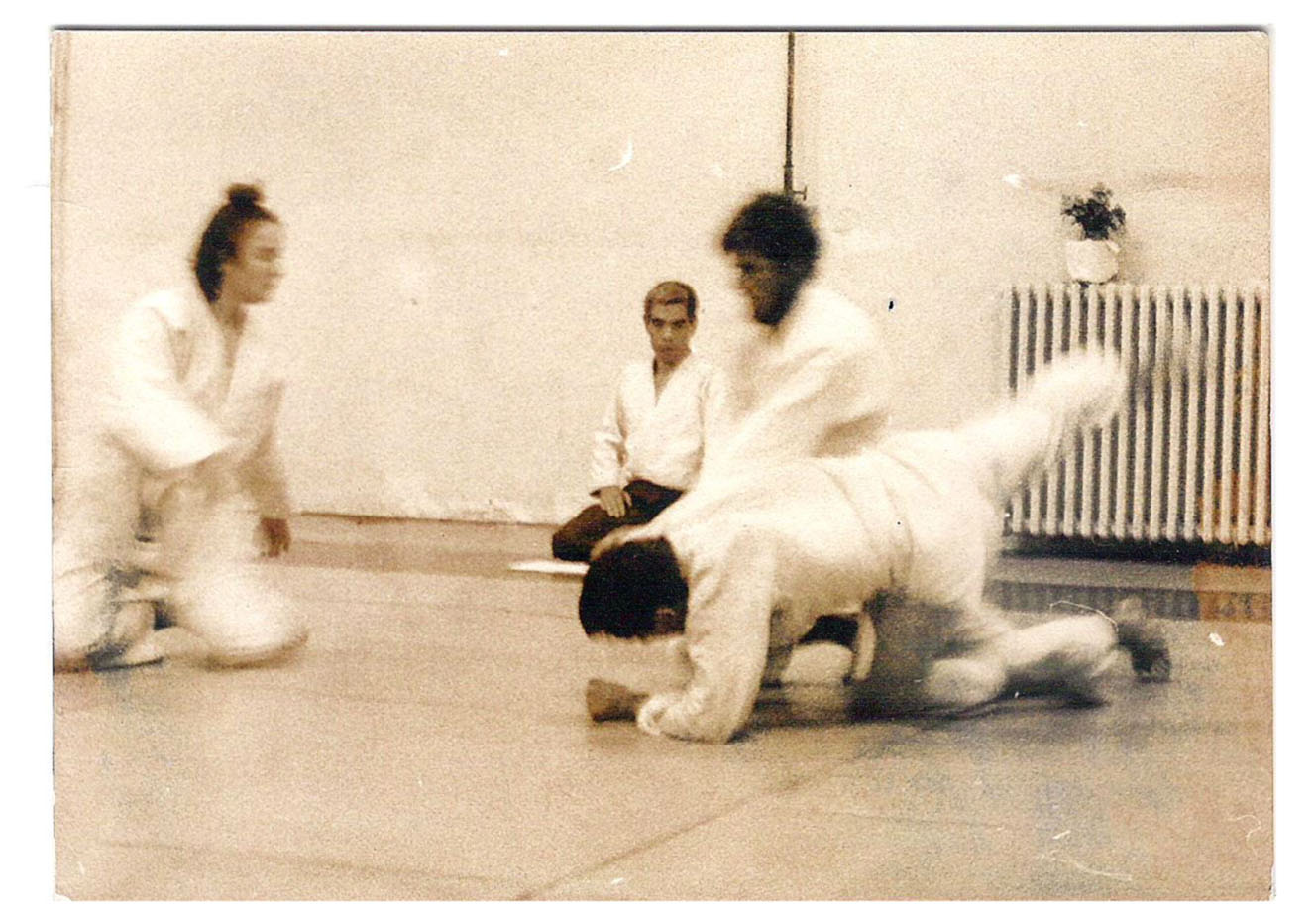
Examinetion held by Hosokawa sensei in 1984. From Left Jelena Vrzić, Hosokava sensei, Milutin Karaičić, Zoran Obradović
Fujimoto sensei hadn’t been coming to Belgrade for two years, so Milutin, Zoran and I, the whole of our generation, couldn’t move from 2nd kyu. Finding out about not being able to be examined at home, Hosokawa sensei agreed to give an examination with the permission of Fujimoto sensei. So I took my 1st kyu examination with Hosokawa sensei in January 1984. It was the last seminar attended by Jovica Stanojević.
After his death on 18 May, Fujimoto sensei started giving seminars once again. In November of the same year, my generation and I passed 1st DAN examination, the same time when the first generation of Jovica’s students passed their 3rd DAN examination.
Once, we were on our way back home from Novi Sad, where we went to help another aikido club. Jovica’s best man started an aikido club in his brother’s sculptor atelier in the Serbian National theather. We were driving at night, through the snow back to Belgrade in Drago’s car. Jovica looked at me and said: ‘This is going to be the first female aikido master in Serbia.’ When it happenned, in November 1984, and after Fujimoto came to congratulate to me, took off his hakama and went to the dressing room, my teacher, Jovica Stanojević, wasn’t there with me but my first thoughts were for him. So, once again, ‘THANK YOU VERY MUCH!’
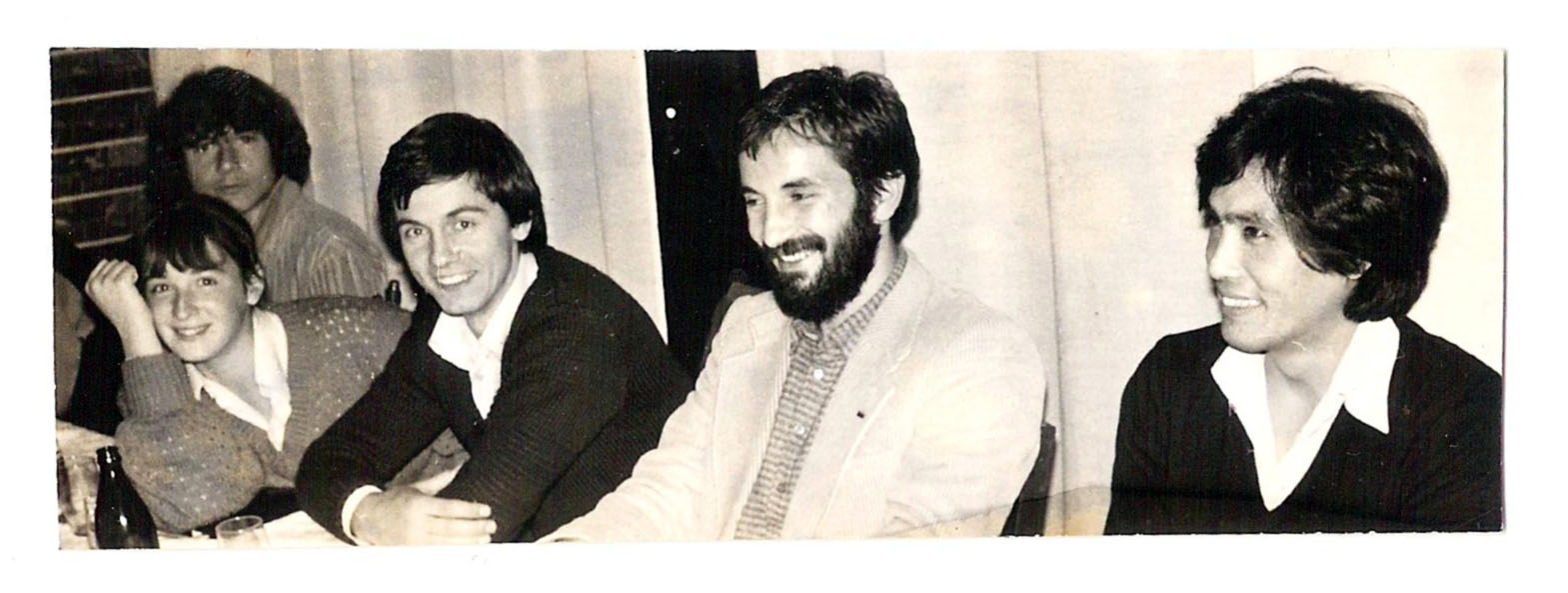
Jelena Vrzić, Drago Bogdanović, Jovica Stanojević, Fujimoto sensei
SA: Fujimoto sensei was the technical director of the Yugoslav aikido federation
JV: Yes, he was the technical director for 20 years.
SA: There’s an interesting story about whether the technical director was going to be him or Hosokawa sensei.
JV: That’s true. At the time of the decision, Hosokawa sensei did aikido brutaly. Each time he joined any training group, it got separated. They say it was quite painful because, though he was quite short, he was swift and as quick as the lightning. However, he was a very profound person and extraordinary aikido teacher. Tada sensei was also quite rough in the early years. That was, simply, the way aikido was done at the time. During the past years, we gradually came to what we do today – less painful aikido. Jovica admired Fujimoto sensei’s large movements and it made all the difference in deciding on the technical director. The two of them were very close friends.
End of part one.

